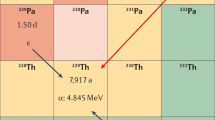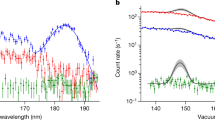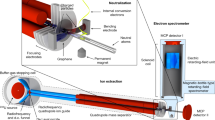Abstract
Thorium-229 (229Th) possesses an optical nuclear transition between the ground state (229gTh) and low-lying isomer (229mTh). A nuclear clock based on this nuclear-transition frequency is expected to surpass existing atomic clocks owing to its insusceptibility to surrounding fields1,2,3,4,5. In contrast to other charge states, triply charged 229Th (229Th3+) is the most suitable for highly accurate nuclear clocks because it has closed electronic transitions that enable laser cooling, laser-induced fluorescence detection and state preparation of ions1,6,7,8. Although laser spectroscopic studies of 229Th3+ in the nuclear ground state have been performed8, properties of 229mTh3+, including its nuclear decay lifetime that is essential to specify the intrinsic linewidth of the nuclear-clock transition, remain unknown. Here we report the trapping of 229mTh3+ continuously supplied by a 233U source and the determination of nuclear decay half-life of the isolated 229mTh3+ to be \({{\rm{1,400}}}_{-300}^{+600}\,{\rm{s}}\) through nuclear-state-selective laser spectroscopy. Furthermore, by determining the hyperfine constants of 229mTh3+, we reduced the uncertainty of the sensitivity of the 229Th nuclear clock to variations in the fine-structure constant by a factor of four. These results offer key parameters for the 229Th3+ nuclear clock and its applications in the search for new physics.
This is a preview of subscription content, access via your institution
Access options
Access Nature and 54 other Nature Portfolio journals
Get Nature+, our best-value online-access subscription
$29.99 / 30 days
cancel any time
Subscribe to this journal
Receive 51 print issues and online access
$199.00 per year
only $3.90 per issue
Buy this article
- Purchase on Springer Link
- Instant access to full article PDF
Prices may be subject to local taxes which are calculated during checkout




Similar content being viewed by others
Data availability
The data that support the findings of this study are available from the corresponding author on request.
References
Peik, E. & Tamm, C. Nuclear laser spectroscopy of the 3.5 eV transition in Th-229. Europhys. Lett. 61, 181–186 (2003).
Peik, E. & Okhapkin, M. Nuclear clocks based on resonant excitation of γ-transitions. C. R. Phys. 16, 516–523 (2015).
Beeks, K. et al. The thorium-229 low-energy isomer and the nuclear clock. Nat. Rev. Phys. 3, 238–248 (2021).
Peik, E. et al. Nuclear clocks for testing fundamental physics. Quantum Sci. Technol. 6, 034002 (2021).
Campbell, C. J. et al. Single-ion nuclear clock for metrology at the 19th decimal place. Phys. Rev. Lett. 108, 120802 (2012).
Klinkenberg, P. F. A. Spectral structure of trebly ionized thorium, Th IV. Physica B+C 151, 552–567 (1988).
Campbell, C. J. et al. Multiply charged thorium crystals for nuclear laser spectroscopy. Phys. Rev. Lett. 102, 233004 (2009).
Campbell, C. J., Radnaev, A. G. & Kuzmich, A. Wigner crystals of 229Th for optical excitation of the nuclear isomer. Phys. Rev. Lett. 106, 223001 (2011).
Seiferle, B. et al. Energy of the 229Th nuclear clock transition. Nature 573, 243–246 (2019).
Beck, B. R. et al. Energy splitting of the ground-state doublet in the nucleus 229Th. Phys. Rev. Lett. 98, 142501 (2007).
Yamaguchi, A. et al. Energy of the 229Th nuclear clock isomer determined by absolute γ-ray energy difference. Phys. Rev. Lett. 123, 222501 (2019).
Sikorsky, T. et al. Measurement of the 229Th isomer energy with a magnetic microcalorimeter. Phys. Rev. Lett. 125, 142503 (2020).
Kraemer, S. et al. Observation of the radiative decay of the 229Th nuclear clock isomer. Nature 617, 706–710 (2023).
Arvanitaki, A., Huang, J. & Van Tilburg, K. Searching for dilaton dark matter with atomic clocks. Phys. Rev. D 91, 015015 (2015).
Tsai, Y.-D., Eby, J. & Safronova, M. S. Direct detection of ultralight dark matter bound to the Sun with space quantum sensors. Nat. Astron. 7, 113–121 (2023).
Brzeminski, D., Chacko, Z., Dev, A., Flood, I. & Hook, A. Searching for a fifth force with atomic and nuclear clocks. Phys. Rev. D 106, 095031 (2022).
Flambaum, V. V. Enhanced effect of temporal variation of the fine structure constant and the strong interaction in 229Th. Phys. Rev. Lett. 97, 092502 (2006).
Safronova, M. S. et al. Search for new physics with atoms and molecules. Rev. Mod. Phys. 90, 025008 (2018).
Fadeev, P., Berengut, J. C. & Flambaum, V. V. Sensitivity of 229Th nuclear clock transition to variation of the fine-structure constant. Phys. Rev. A 102, 052833 (2020).
von der Wense, L. & Seiferle, B. The 229Th isomer: prospects for a nuclear optical clock. Eur. Phys. J. A 56, 277 (2020).
von der Wense, L., Seiferle, B., Laatiaoui, M. & Thirolf, P. G. Determination of the extraction efficiency for 233U source α-recoil ions from the MLL buffer-gas stopping cell. Eur. Phys. J. A 51, 29 (2015).
von der Wense, L. et al. Direct detection of the 229Th nuclear clock transition. Nature 533, 47–51 (2016).
von der Wense, L., Seiferle, B., Laatiaoui, M. & Thirolf, P. G. The extraction of 229Th3+ from a buffer-gas stopping cell. Nucl. Instrum. Methods Phys. Res. B 376, 260–264 (2016).
Barci, V. et al. Nuclear structure of 229Th from γ-ray spectroscopy study of 233U α-particle decay. Phys. Rev. C 68, 034329 (2003).
Thielking, J. et al. Laser spectroscopic characterization of the nuclear-clock isomer 229mTh. Nature 556, 321–325 (2018).
Wada, M. et al. Slow RI-beams from projectile fragment separators. Nucl. Instrum. Methods Phys. Res. B 204, 570–581 (2003).
Churchill, L. R., DePalatis, M. V. & Chapman, M. S. Charge exchange and chemical reactions with trapped Th3+. Phys. Rev. A 83, 012710 (2011).
Porsev, S. G., Safronova, M. S. & Kozlov, M. G. Precision calculation of hyperfine constants for extracting nuclear moments of 229Th. Phys. Rev. Lett. 127, 253001 (2021).
Berengut, J. C., Dzuba, V. A., Flambaum, V. V. & Porsev, S. G. Proposed experimental method to determine α sensitivity of splitting between ground and 7.6 eV isomeric states in 229Th. Phys. Rev. Lett. 102, 210801 (2009).
Zhang, W. et al. Ultrastable silicon cavity in a continuously operating closed-cycle cryostat at 4 K. Phys. Rev. Lett. 119, 243601 (2017).
Dykhne, A. M., Eremin, N. V. & Tkalya, E. V. Alpha decay of the first excited state of the Th-229 nucleus. J. Exp. Theor. Phys. Lett. 64, 345–349 (1996).
Porsev, S. G. & Flambaum, V. V. Effect of atomic electrons on the 7.6-eV nuclear transition in 229Th3+. Phys. Rev. A 81, 032504 (2010).
Müller, R. A., Volotka, A. V., Fritzsche, S. & Surzhykov, A. Theoretical analysis of the electron bridge process in 229Th3+. Nucl. Instrum. Methods Phys. Res. B 408, 84–88 (2017).
Dykhne, A. M. & Tkalya, E. V. Matrix element of the anomalously low-energy (3.5±0.5 eV) transition in 229Th and the isomer lifetime. J. Exp. Theor. Phys. Lett. 67, 251–256 (1998).
Ruchowska, E. et al. Nuclear structure of 229Th. Phys. Rev. C 73, 044326 (2006).
Tkalya, E. V., Schneider, C., Jeet, J. & Hudson, E. R. Radiative lifetime and energy of the low-energy isomeric level in 229Th. Phys. Rev. C 92, 054324 (2015).
Minkov, N. & Pálffy, A. Reduced transition probabilities for the gamma decay of the 7.8 eV isomer in 229Th. Phys. Rev. Lett. 118, 212501 (2017).
Minkov, N. & Pálffy, A. Theoretical predictions for the magnetic dipole moment of 229mTh. Phys. Rev. Lett. 122, 162502 (2019).
Minkov, N. & Pálffy, A. 229mTh isomer from a nuclear model perspective. Phys. Rev. C 103, 014313 (2021).
Shigekawa, Y. et al. Estimation of radiative half-life of 229mTh by half-life measurement of other nuclear excited states in 229Th. Phys. Rev. C 104, 024306 (2021).
Tkalya, E. V. Spontaneous emission probability for M1 transition in a dielectric medium: 229mTh(3/2+, 3.5±1.0 eV) decay. J. Exp. Theor. Phys. Lett. 71, 311–313 (2000).
Seiferle, B., von der Wense, L. & Thirolf, P. G. Lifetime measurement of the 229Th nuclear isomer. Phys. Rev. Lett. 118, 042501 (2017).
Hayes, A. C., Friar, J. L. & Möller, P. Splitting sensitivity of the ground and 7.6 eV isomeric states of 229Th. Phys. Rev. C 78, 024311 (2008).
Litvinova, E., Feldmeier, H., Dobaczewski, J. & Flambaum, V. Nuclear structure of lowest 229Th states and time-dependent fundamental constants. Phys. Rev. C 79, 064303 (2009).
Safronova, U. I., Johnson, W. R. & Safronova, M. S. Excitation energies, polarizabilities, multipole transition rates, and lifetimes in Th IV. Phys. Rev. A 74, 042511 (2006).
Bollen, G. “Ion surfing” with radiofrequency carpets. Int. J. Mass Spectrom. 299, 131–138 (2011).
Kopfermann, H. Nuclear moments. Nucl. Phys. 16, 188 (1960).
Safronova, M. S. et al. Nuclear charge radii of 229Th from isotope and isomer shifts. Phys. Rev. Lett. 121, 213001 (2018).
Angeli, I. & Marinova, K. P. Table of experimental nuclear ground state charge radii: an update. At. Data Nucl. Data Tables 99, 69–95 (2013).
Kälber, W. et al. Nuclear radii of thorium isotopes from laser spectroscopy of stored ions. Z. Phys. A 334, 103–108 (1989).
Acknowledgements
The 233U sample used in this paper was provided by the 233U cooperation project between the Japan Atomic Energy Agency and the Inter-University Cooperative Research Program of the Institute for Materials Research, Tohoku University (proposal nos. 17K0204, 17F0011 and 18F0014). This work was supported by JST PRESTO (grant number JPMJPR1868), JSPS KAKENHI (grant nos. JP19H00685, JP21H04473, JP22H04946 and JP23H00094) and Yamada Science Foundation.
Author information
Authors and Affiliations
Contributions
A.Y. and Y.S. contributed to building the experimental setup, performed the measurements and analysed the data. A.Y., Y.S., H.Ki., K.S. and H.H. contributed to developing the 233U source. M.W. contributed to developing the ion manipulation system, including an RF carpet and a PCB-based quadrupole ion guide. All works were supervised by H.Ka., H.H. and M.W. All authors discussed the results and contributed to the manuscript.
Corresponding author
Ethics declarations
Competing interests
The authors declare no competing interests.
Peer review
Peer review information
Nature thanks Xu Wang and the other, anonymous, reviewer(s) for their contribution to the peer review of this work.
Additional information
Publisher’s note Springer Nature remains neutral with regard to jurisdictional claims in published maps and institutional affiliations.
Extended data figures and tables
Extended Data Fig. 1 Doppler-broadened spectrum of the 5f 2F5/2 ↔ 6d 2D5/2 transition of 229gTh3+.
The red curve represents the background-subtracted fluorescence count rate at 984 nm as a function of the 690-nm laser frequency. Vertical blue bars denote hyperfine transitions \(({F}_{{\rm{g}}}^{{\rm{i}}}\to {F}_{{\rm{g}}}^{{\rm{f}}})\) whose frequencies were calculated on the basis of refs. 7,8. The relative height of the blue bars represents the relative strength of the calculated absorption cross-sections of each hyperfine transition. The black curve represents the summation of Gaussian functions corresponding to each hyperfine transition, for which the width and scaling factor were determined from the fitting of the isolated 5 → 4 peak.
Extended Data Fig. 2 Dependence of decay rate on laser irradiation time.
Dependence of the decay rate on the duty ratio of the laser irradiation time was evaluated for 229gTh3+ (a) and 229mTh3+ (b). Each decay-rate measurement was conducted by repeating a 24-s sequence, in which all three lasers were on for tON s and off for (24 − tON) s. The duty ratio is calculated as tON/24. The error bars represent the standard deviation of the mean. From the linear fitting shown as a solid line, the decay rate for no laser irradiation was estimated to be 8.94(11) × 10−4 s−1 for the ground state and 1.47(15) × 10−3 s−1 for isomer.
Extended Data Fig. 3 Determination of the resonance frequency \(({{\boldsymbol{\nu }}}_{{\bf{m}},{\bf{HF}}}^{690})\) of the |5f 2F5/2, Fm = 1⟩ → |6d 2D5/2, Fm = 2⟩ transition.
a, The spectra of the |5f 2F5/2, Fm = 1⟩ → |6d 2D3/2, Fm = 2⟩ transition (1,088 nm) were measured with several 690-nm laser frequencies around the resonance frequency of the |5f 2F5/2, Fm = 1⟩ → |6d 2D5/2, Fm = 2⟩ transition. From bottom to top, the 690-nm laser frequency was increased by 100 MHz at each step. The spectra were vertically shifted by 1.5 × 105 s−1 at each step for clarity. b, The spectral area was determined by fitting (black line) and plotted as a function of the 690-nm laser frequency. The resonance frequency \({\nu }_{{\rm{m}},{\rm{HF}}}^{690}\) was determined to be the one that gives the largest spectral area. The error bars represent the standard deviation of the mean.
Extended Data Fig. 4 Observations of all 229mTh3+ hyperfine resonances on the 5f 2F5/2 → 6d 2D3/2 and 5f 2F5/2 → 6d 2D5/2 transitions.
a–g, All of the hyperfine transitions on the 5f 2F5/2 → 6d 2D3/2 (1,088 nm) and 5f 2F5/2 → 6d 2D5/2 (690 nm) transitions, which were not contained in Fig. 3b–d, were observed. Definitions of the blue, orange, brown and green curves are same as in Fig. 3b–d. The purple bars indicate the resonance frequencies of each transition calculated using the hyperfine constants and isomer shifts obtained in this study. The width of the purple bar represents the uncertainty of the calculated values. The corresponding hyperfine transitions \(|5f\,{}^{2}{F}_{5/2},{F}_{{\rm{m}}}^{{\rm{i}},690}\rangle \to |6d\,{}^{2}{D}_{5/2},{F}_{{\rm{m}}}^{{\rm{f}},690}\rangle \) (690 nm) and \(|5f\,{}^{2}{F}_{5/2},{F}_{{\rm{m}}}^{{\rm{i}},\,1,088}\rangle \to |6d\,{}^{2}{D}_{3/2},{F}_{{\rm{m}}}^{{\rm{f}},1,088}\rangle \) (1,088 nm) are shown at the top of each figure as \({F}_{{\rm{m}}}^{{\rm{i}},690}\to {F}_{{\rm{m}}}^{{\rm{f}},690}\) and \({F}_{{\rm{m}}}^{{\rm{i}},1,088}\to {F}_{{\rm{m}}}^{{\rm{f}},1,088}\). We measured the spectrum a only with \({\nu }_{{\rm{B}}}^{984}\) because there were no overlapped 229gTh3+ resonances in the scanned frequency range.
Rights and permissions
Springer Nature or its licensor (e.g. a society or other partner) holds exclusive rights to this article under a publishing agreement with the author(s) or other rightsholder(s); author self-archiving of the accepted manuscript version of this article is solely governed by the terms of such publishing agreement and applicable law.
About this article
Cite this article
Yamaguchi, A., Shigekawa, Y., Haba, H. et al. Laser spectroscopy of triply charged 229Th isomer for a nuclear clock. Nature (2024). https://doi.org/10.1038/s41586-024-07296-1
Received:
Accepted:
Published:
DOI: https://doi.org/10.1038/s41586-024-07296-1
Comments
By submitting a comment you agree to abide by our Terms and Community Guidelines. If you find something abusive or that does not comply with our terms or guidelines please flag it as inappropriate.



